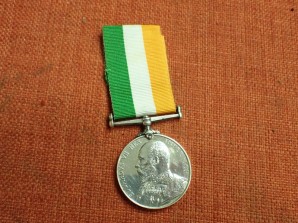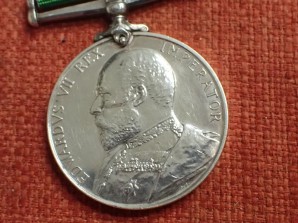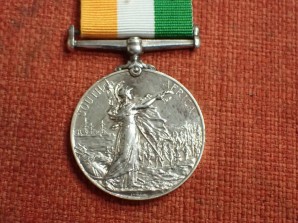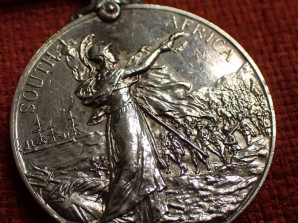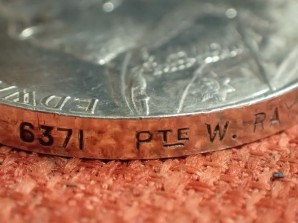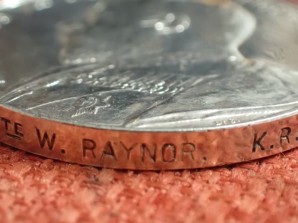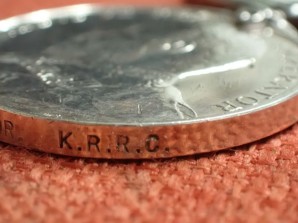BOER-WAR K.S.A. MEDAL, K.R.R.C.
Stock No. 132908
Product Information
Out of Stock
VERY CRISP AND CLEAN KINGS SOUTH AFRICA SOLID SILVER MEDAL. “6371 PTE. W.RAYNOR, K.R.R.CORP. RECORDS SHOW THAT RAYNOR WAS IN THE 3RD BATTALION OF THE KINGS ROYAL RIFLE CORPS DURING THE BOER WAR, THE HISTORY OF THE 3RD KRRC -
The 3rd Battalion sailed on the Servia on 4th November 1899, arrived at the Cape about the 24th, and was sent on to Durban. Along with the 2nd Scottish Rifles, 1st Durham Light Infantry, and 1st Rifle Brigade, they formed the 6th Brigade under Major General N G Lyttelton. An account of the work of the brigade is given under the 2nd Scottish Rifles, and of that of the Natal Army generally under the 2nd Queen’s.
At Colenso the battalion was not in the thickest, being, along with the 2nd Scottish Rifles, escort to Captain Jones’s two 47 naval guns and four 12-pounder guns. They had almost no casualties. Their first heavy fighting was on 24th January 1900. A sketch of the great combat on Spion Kop is given under the 2nd Royal Lancaster, and reference is also made to the 2nd Scottish Rifles, whose task that day was not unlike that of the 3rd King’s Royal Rifles. In the Natal Army despatches (Blue-Book, p 79) there is an admirably clear report by Major Bewick-Copley of what the battalion did. Leaving Spearman’s Hill at 10 am, they crossed the Tugela and advanced in widely extended order against the Twin Peaks north-east of Spion Kop, the right-half battalion attacking the right hill, called Sugar-Loaf Hill, and the left-half battalion the other hill. Both hills and the nek between them were strongly held. At 4.45 pm the Sugar-Loaf Hill was carried, “the Boers only leaving as the men’s swords came over the crest-line”. Lieutenant Colonel Buchanan-Riddell was killed as he cheered his men in the final rush. Shortly afterwards the left hill was carried by Major Bewick-Copley’s command. “Though still under a galling fire from both flanks, we were able to stop the fire of the machine guns 150 yards to our front, and also to keep down the fire of the Boers, which was being directed on to the right flank of Sir Charles Warren’s troops, holding the main ridge of Spion Kop”. About 6.30 the battalion received General Lyttelton’s order to retire, and “by midnight had recrossed the Tugela practically unmolested”. The fact that the hills were so very steep, and that the operation was very skilfully carried out, rendered the casualty list less heavy than was to have been expected. The battalion’s losses were approximately 17 killed and 61 wounded, almost precisely the same as that of the Cameronians. Another very good account of this engagement is to be found in the King’s Royal Rifle Corps Chronicle for 1901.
The evacuation of Spion Kop has been greatly discussed by those who are in authority and by those who are not, but the evacuation of the Twin Peaks seems to have been criticised by the latter class only. The question has been touched on under the Royal Lancasters. No doubt General Lyttelton had reason to be nervous about the safety of the battalion, but it is a truism that in war big risks must be taken. The Commander-in-Chief was the one to take the risk, and we are forced back to the belief that a greater centralisation of authority in himself and more rigorous use of it, regardless of all susceptibilities, might have made the story of the 24th January less heartrending. This is, of course, the tenor of Lord Roberts’ covering despatch of 13th February 1900.
The battalion took part in the storming of Vaal Krantz, where their losses were approximately 1 officer and 20 men wounded. They were also in the work between 13th and 27th February, and after the Tugela was crossed had some very heavy fighting. During the fourteen days’ fighting the losses of the King’s Royal Rifles, including those of officers and men in the Composite Battalion, were approximately 1 officer and 16 men killed, 5 officers and 84 men wounded.
Three officers and 25 men were mentioned in despatches for work in the relief operations, 3 men being recommended for the distinguished conduct medal.
The 3rd King’s Royal Rifles, like the other regiments of the 4th Brigade, were chiefly employed in guarding the railway line and fighting on either side of it after the forces of Lord Roberts and General Buller had joined hands.
In General Buller’s final despatch of 9th November 1900, 3 officers and 5 non-commissioned officers and men were mentioned.
On 28th July 1900 Major General Cooper, with the 3rd King’s Royal Rifles and 1st Rifle Brigade, took over Heidelberg from Hart, and in this district the home or headquarters of the battalion was long to remain. Garrison duty and column work occupied their energies to the close of the campaign. For about the last eight months of the war the battalion was garrison at Machadodorp.
For note as to commendations by Lord Roberts and Lord Kitchener see 1st Battalion.

